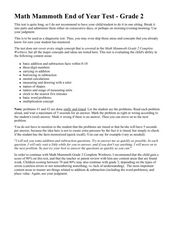Google
Surveys and Estimating Large Quantities
Looking for an estimation activity a bit more involved than the typical "guess the number of jellybeans in the jar" game? Here, learners use a picture to estimate the number of people at a large event, look for potential problems with...
Curated OER
Adding Animals
Writing equations from images helps young mathematicians grasp addition, especially when they get to look at cute animals as they do it. There are six number sentences here, each illustrated with a set of animals corresponding to...
Education Creations
Morning Math
Jump-start your morning mathematicians with this set of warm ups! Consider simply projecting the problem of the day for the entire class and having them complete the work in individual notebooks or with a partner. Concepts include...
Curated OER
RHYTHMIC PATTERNS
Students explore rhythmic patterns. They create and perform the rhythms and use Cubase software to perform, record, and play rhythms for use in dictation exercises. They identify and count rhythm patterns
DK Publishing
Eggs in a Nest - Dividing by 2
How can each set of eggs be divided between two nests? Practice dividing by two as scholars examine seven nests and write number sentences to represent each. Each nest has an even number of eggs, so they always divide evenly. The largest...
Curated OER
Fractions
What fraction is represented by these shapes? Scholars examine fraction models as they apply basic fraction skills. The first two problems are guided; they look at a set of shapes with some shaded, circling (from three options) the...
Curated OER
Mixed Tables
How many pennies does each person get? There are four visual division problems for young mathematicians to solve, and they divide 12 pennies among a set of people for each. They draw the coins above each recipient and then write the...
Curated OER
Black Tiger Academy Martial Arts Fitness Unit - Lesson 16
“The person who really wants to do something finds a way; the other person finds an excuse.”—Author Unknown. Black Tiger Academy’s martial arts lesson 16 of 20 begins talking about calories. The class takes a look at menus from Burger...
Nuffield Foundation
Measuring the Rate of Metabolism
Plant respiration can be a difficult concept for young biologists to grasp; with a hands-on lab, learners can collect and graph data, then calculate the metabolism rate for the plants they studied. If you do not have a respirometer,...
Charleston School District
Review Unit 4: Linear Functions
It's time to show what they know! An assessment review concludes a five-part series about linear functions. It covers all concepts featured throughout the unit, including linear equations, graphs, tables, and problem solving.
Inside Mathematics
Snakes
Get a line on the snakes. The assessment task requires the class to determine the species of unknown snakes based upon collected data. Individuals analyze two scatter plots and determine the most likely species for five...
Curated OER
Line of Best Fit
In this line of best fit instructional activity, students solve and complete 8 different problems that include plotting and creating their own lines of best fit on a graph. First, they study the samples at the top and plot the ordered...
Curated OER
Lakes of Methane on Titan
In this methane lakes worksheet, students read about the false-color synthetic radar map taken by the Cassini spacecraft indicating methane lakes on Titan. Students solve 4 problems about the surface area of the lakes from the image, and...
Curated OER
Developing Strategies for Addition and Subtraction
Primary graders develop strategies to assist them with addition and subtraction. They discover number combinations and numerical facts which enable them to add and subtract more effectively. Young scholars use these techniques to...
DK Publishing
Number Riddles - Word Problems
Although this set of 16 word problems aren't the most riveting, they give clear practice opportunities for learners to solve missing factor and dividend problems. Each scenario is only a sentence or two, and some don't even involve...
National Security Agency
Going Green with Graphs
In this unit designed for second graders, youngsters are introduced to conducting surveys and creating tally charts based on the data they gather. Students then construct bar graphs, and observe the relationships between the two...
Curated OER
Operating on Matrices
Learners investigate matrices by exploring addition, subtraction and multiplication of matrices. Students find the determinant and inverse of a matrix. The lesson includes a set of practice problems
Curated OER
Math Mammoth End of Year Test - Grade 2
Assess your second graders with this end of the year test. Originally meant for home school, this assessment could also be used in a larger setting. Learners complete 35 problems based on their knowledge of the second grade math...
Curated OER
Lines of Symmetry
Drawing lines of symmetry helps scholars understand shape attributes, basic fractions, and equality. They determine how many lines each of these nine shapes has, using an example as reference. Consider having learners cut out a set of...
Illustrative Mathematics
Chess Club
When the membership in a chess club changes, it is your mathematicians' job to find out how many boys and girls are attending and the percent change from last year. The activity provides a great compound problem finding the different...
West Contra Costa Unified School District
Solving a System by Substitution
Solving systems by substitution can be a challenging topic in algebra I. Here is a lesson that builds on students' understanding of intercepts to begin the process of substitution, and all work is reinforced graphically to build...
Curated OER
Marble Game
Learners practice counting groups of items of six or more. They create equivalent sets.
Curated OER
Pennies, Nickels, and Dimes
For this counting coins worksheet, students identify the coins in the 5 sets of problems. Students then count up the pennies, nickels, and dimes to determine the total value of money.
Curated OER
Zero Is Our Hero
Students engage in a lesson that is concerned with the mastery of counting by ten's. They practice counting to varying quantities not to exceed 100. Students could also use manipulatives that are separated into groups of ten.























